Competition Maneuvers of
Keluarga Pencak Silat Nusantara (VII)
Rapid Journal, Vol. 8, No. 3 (Book 29, 2004: 44-45)
© O'ong Maryono
www.kpsnusantara.com
Here we will continue exploring the KPS Nusantara competition maneuvers proceeding with the seventh sequel or jurus pertandingan VII, as performed by Abdul Karim Jabad trainer of KPS Nusantara at Rizal Memorial Stadium, Manila and a national coach. Again it should be noticed that there are many similarities with the maneuvers in the previous jurus pertandingan and that the differences mostly lie in the order of movements resulting in different degrees of difficulty.
Defense and Attack Tactics
The pesilat standing position signals that the pesilat is ready to fight (standing position XII or sikap dua belas; fig.1). From this position the pesilat enters into action changing to standing position IV (sikap empat; fig. 2). It looks like the pesilat can easily be attacked, but actually this is a trick for the opponent to entice him/her to attack. From this position, the pesilat besides holding out, can use the hands to carry out deadlock techniques, or even catch and break the opponent’s hands and legs. If the opponent is not tricked into attacking and remains passive, the pesilat can use the “dragon” blocking (tangkisan liuk; fig.3) and quickly step back (egos belakang; fig. 4) to suddenly attack with a side kick (tendangan T; fig.5) followed by a back punch (punggung tangan; fig. 6), round kick strike (tendangan serong; fig. 7) and finally a right hook (pukulan sudut; fig. 8).
 |
 |
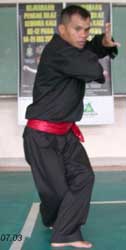 |
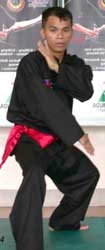 |
fig 1 |
fig 2 |
fig 3 |
fig 4 |
 |
 |
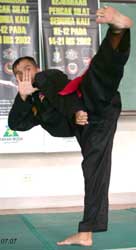 |
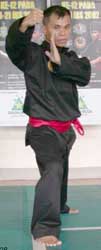 |
fig 5 |
fig 6 |
fig 7 |
fig 8 |
In closure, the striking pesilat steps back two times, turns into a flying eagle standing position (elang melayang: fig. 9 and 10) and goes back to standby position (sikap siap)(fig.11) in preparation for the following pattern of movements to be discussed in the next issue. .
 |
 |
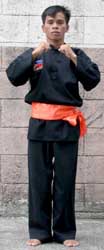 |
| fig 9 | fig 10 | fig 11 |
O
back to main page • back to articles from Rapid Journal • next article